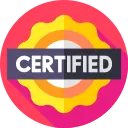FREE
daily Instructor: Dr. Kent JohnsonCourse Overview
Mastering Front-End Development with React
React Fundamentals
- Deep dive into React's component-based architecture: Learn to build reusable UI components that manage their own state and render efficiently.
- Understanding JSX (JavaScript XML): Master the syntax extension that allows you to write HTML-like structures within JavaScript, enhancing code readability and component composition.
- State Management: Explore local component state using the `useState` hook, understanding its role in triggering re-renders and managing dynamic data within components.
- Props: Learn how to pass data from parent to child components using props, ensuring unidirectional data flow and component reusability.
- Conditional Rendering: Implement dynamic UI updates by conditionally rendering components or elements based on specific conditions, using techniques like ternary operators and logical AND.
Advanced React Concepts
- Hooks API: Gain proficiency in using built-in hooks like `useEffect` for managing side effects (data fetching, subscriptions), `useContext` for global state management, and `useRef` for accessing DOM elements directly.
- Custom Hooks: Create your own reusable hooks to encapsulate complex logic and state management, improving code maintainability and reducing redundancy.
- Context API: Implement a global state management solution using the Context API, allowing components to access and update shared data without prop drilling.
- Higher-Order Components (HOCs): Understand and create HOCs to add functionality to components, promoting code reuse and separation of concerns.
- Render Props: Explore the render props pattern as an alternative to HOCs, allowing components to share code by passing a function that renders the desired content.
- React Router: Implement client-side routing using React Router, enabling navigation between different views or pages within a single-page application (SPA). Learn to define routes, create links, and handle route parameters.
React Performance Optimization
- Code Splitting: Optimize application loading times by splitting the codebase into smaller chunks that are loaded on demand, using techniques like dynamic imports.
- Memoization: Prevent unnecessary re-renders of components by memoizing them using `React.memo`, ensuring that they only update when their props change.
- Virtualization: Implement techniques like windowing or virtualization to efficiently render large lists or tables, improving performance and reducing memory usage.
- Profiling: Use React DevTools to profile component rendering performance, identifying bottlenecks and areas for optimization.
Backend Development with Node.js and Express
Node.js Fundamentals
- Asynchronous JavaScript: Understand the event loop and asynchronous programming patterns in Node.js, using callbacks, Promises, and async/await to handle non-blocking operations.
- Modules: Develop reusable code modules using the Node.js module system, exporting and importing functions, classes, and data.
- NPM (Node Package Manager): Utilize NPM to manage dependencies, install packages, and create projects using package.json.
- File System Operations: Learn to read, write, and manipulate files and directories using the Node.js file system module.
- Streams and Buffers: Work with streams and buffers to efficiently handle large amounts of data, enabling tasks like file uploads and downloads.
Express.js Framework
- Routing: Define routes and handlers to handle HTTP requests to different endpoints using Express.js.
- Middleware: Implement middleware functions to add functionality to the request-response cycle, such as authentication, logging, and error handling.
- Request and Response Objects: Understand the request and response objects, accessing request headers, query parameters, and body data, and sending responses with appropriate status codes and headers.
- Templating Engines: Integrate templating engines like Pug or EJS to generate dynamic HTML pages on the server-side.
- RESTful APIs: Design and implement RESTful APIs using Express.js, following best practices for resource naming, HTTP methods, and response formats.
Database Integration with MongoDB
- MongoDB: Learn the basics of MongoDB, a NoSQL document database, including collections, documents, and queries.
- Mongoose: Use Mongoose, an object-relational mapping (ORM) library for MongoDB, to define schemas, models, and perform CRUD operations.
- Data Modeling: Design efficient data models for your application, considering relationships between collections and optimizing query performance.
- Aggregation: Implement complex data aggregations using the MongoDB aggregation framework, performing calculations, grouping data, and creating reports.
- Data Validation: Implement data validation using Mongoose schemas to ensure data integrity and prevent invalid data from being stored in the database.
Advanced Full Stack Concepts
Authentication and Authorization
- Authentication: Implement user authentication using strategies like local authentication (username/password), social authentication (OAuth), and JSON Web Tokens (JWT).
- Authorization: Implement authorization to control access to resources based on user roles and permissions, using middleware functions to protect routes and data.
- Session Management: Manage user sessions using cookies or session storage, storing user data and tracking user activity across requests.
- Security Best Practices: Implement security best practices to protect your application from common vulnerabilities like Cross-Site Scripting (XSS), Cross-Site Request Forgery (CSRF), and SQL injection.
Deployment and DevOps
- Cloud Deployment: Deploy your application to cloud platforms like AWS, Google Cloud, or Azure, configuring servers, databases, and networking.
- Containerization: Use Docker to containerize your application, creating portable and reproducible environments for deployment.
- Continuous Integration/Continuous Deployment (CI/CD): Implement CI/CD pipelines using tools like Jenkins or Travis CI to automate the build, test, and deployment process.
- Monitoring and Logging: Set up monitoring and logging systems to track application performance, identify errors, and ensure uptime.
Testing
- Unit Testing: Write unit tests for individual components or functions using frameworks like Jest or Mocha, ensuring that they behave as expected.
- Integration Testing: Write integration tests to verify the interaction between different parts of the application, ensuring that they work together correctly.
- End-to-End Testing: Write end-to-end tests using tools like Cypress or Puppeteer to simulate user interactions and verify the overall functionality of the application.
- Test-Driven Development (TDD): Practice TDD by writing tests before implementing the code, ensuring that the code meets the requirements and is easily testable.
FlashCards
External Resources
Add-On Features
Expert Instructor
Get live study sessions from experts
Honorary Certification
Receive a certificate before completing the course.
Currency
Sign in to change your currency
I'm not ready to enroll?
Tell us why, because it matters.
Enroll With a Key
Course Benefits
Get a Job
Use your certificate to stand out and secure new job opportunities.
Earn More
Prove your skills to secure promotions and strengthen your case for higher pay
Learn a Skill
Build knowledge that stays with you and works in real life.
Lead Teams
Use your certificate to earn leadership roles and invitations to industry events.
Visa Support
Use your certificate as proof of skills to support work visa and immigration applications.
Work on Big Projects
Use your certificate to qualify for government projects, enterprise contracts, and tenders requiring formal credentials.
Win Partnerships
Use your certified expertise to attract investors, get grants, and form partnerships.
Join Networks
Use your certificate to qualify for professional associations, advisory boards, and consulting opportunities.
Stand Out Professionally
Share your certificate on LinkedIn, add it to your CV, portfolio, job applications, or professional documents.
Discussion Forum
Join the discussion!
No comments yet. Sign in to share your thoughts and connect with fellow learners.
Frequently Asked Questions
For detailed information about our Full Stack Web Development Certification course, including what you’ll learn and course objectives, please visit the "About This Course" section on this page.
The course is online, but you can select Networking Events at enrollment to meet people in person. This feature may not always be available.
We don’t have a physical office because the course is fully online. However, we partner with training providers worldwide to offer in-person sessions. You can arrange this by contacting us first and selecting features like Networking Events or Expert Instructors when enrolling.
Contact us to arrange one.
This course is accredited by Govur University, and we also offer accreditation to organizations and businesses through Govur Accreditation. For more information, visit our Accreditation Page.
Dr. Kent Johnson is the official representative for the Full Stack Web Development Certification course and is responsible for reviewing and scoring exam submissions. If you'd like guidance from a live instructor, you can select that option during enrollment.
The course doesn't have a fixed duration. It has 25 questions, and each question takes about 5 to 30 minutes to answer. You’ll receive your certificate once you’ve successfully answered most of the questions. Learn more here.
The course is always available, so you can start at any time that works for you!
We partner with various organizations to curate and select the best networking events, webinars, and instructor Q&A sessions throughout the year. You’ll receive more information about these opportunities when you enroll. This feature may not always be available.
You will receive a Certificate of Excellence when you score 75% or higher in the course, showing that you have learned about the course.
An Honorary Certificate allows you to receive a Certificate of Commitment right after enrolling, even if you haven’t finished the course. It’s ideal for busy professionals who need certification quickly but plan to complete the course later.
The price is based on your enrollment duration and selected features. Discounts increase with more days and features. You can also choose from plans for bundled options.
Choose a duration that fits your schedule. You can enroll for up to 180 days at a time.
No, you won't. Once you earn your certificate, you retain access to it and the completed exercises for life, even after your subscription expires. However, to take new exercises, you'll need to re-enroll if your subscription has run out.
To verify a certificate, visit the Verify Certificate page on our website and enter the 12-digit certificate ID. You can then confirm the authenticity of the certificate and review details such as the enrollment date, completed exercises, and their corresponding levels and scores.
Can't find answers to your questions?
Certification Guide

Complete the Course
Begin the course by selecting your experience level in the course content section:
Beginner: Master the material with interactive questions and enough time.
Intermediate: Get certified faster with hints and balanced questions.
Advanced: Challenge yourself with more questions and less time

Earn Your Certificate
To download and share your certificate, you must achieve a combined score of at least 75% on all questions answered.





